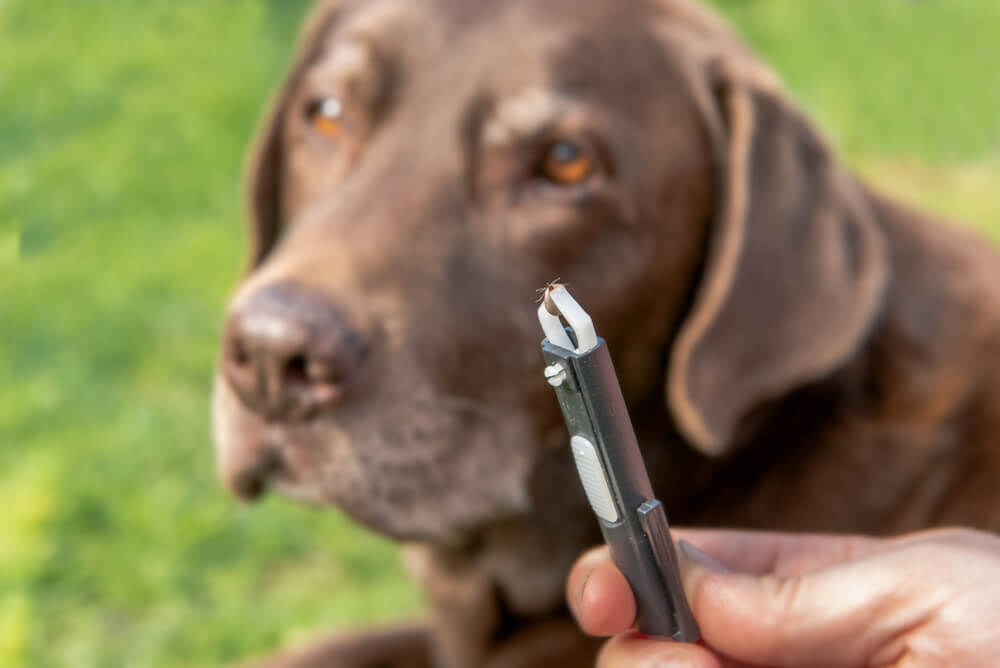How to Remove a Tick From a Dog

Table of Contents
How to Remove a Tick From Your Dog

How to Check Your Dog for Ticks
As a dog owner, you must be watchful for ticks, especially if you live in a tick-dense area. Ticks carry infectious diseases that are harmful to you and your pet. You must remove a tick as soon as possible to avoid serious pathogen transmission.
Below you’ll find advice on how to tell if your dog has ticks, how to feel for them on your dog’s fur, tick disease information, and general dog care to remove a tick safely.
How to Tell if Your Dog Has Ticks
Look out for these warning signs that could signal a tick bite on your pet:
- lethargy and reduced energy
- loss of appetite
- fever
- yelping and sensitive to touch due to discomfort
- lameness, or wobbly stance and walk
- unexplained scabbing
- signs of anemia (nose bleeds, pale gums, bruising, bloody stools)
Scan for Ticks
Check your dog’s body for ticks by running your fingers through their fur. Press gently and feel for any bumps on your pet’s skin surface. Depending on how long the tick has been on their skin, the mite could be as small as a poppy seed or as large as a grape.
Be thorough by checking your dog’s toes, ears, armpits, anus, belly, and between any skin folds.

Check if It’s a Tick
Ticks are parasites that fasten themselves to people and animals who come in contact with their habitat (grass, bushes, etc.) They feed on the blood of their new host and can transmit diseases within 3-6 hours.
Different tick species can transmit various diseases to animals. Below are the most common tick species in America:
Lone Star Tick
Where and when: The Lone Star Tick is found in the southeastern and eastern U.S. Their habitat is usually wooded and bushy areas near creeks and river bottoms. These pests are present all year round but are more common during warmer seasons.
Appearance: Lone Star Ticks are shades of brown or tan. You can identify females by a silvery-white spot on their back, while the males have sprinkled white spots.
Risk: A Lone Star Tick bite can cause Canine Where and when: The American Dog Tick is popular in the Rocky Mountains, limited areas of the Pacific Coast, and over most of North America. They thrive in forest edges, grassy fields, scrubland, and trails. These mites are ready to spring onto a new host during warmer seasons. Appearance: Adult American Dog Ticks are brown with white flecks on their backs. Females can take on a gray appearance when engorged. Risk: The American Dog Tick can cause Rocky Mountain Spotted Fever, Tularemia, and Canine Ehrlichiosis Where and when: The Brown Dog Tick can be found worldwide (except in Alaska). During all life stages, the Brown Dog Tick primarily targets dogs as their host; however, they will also bite humans and other mammals. They are known to hide in homes, kennels, and cracks. Appearance: This species has no noticeable markings and are reddish-brown. Risk: The Brown Dog Tick transmits Rocky Mountain Spotted Fever and Canine Ehrlichiosis. Where and when: Your dog may encounter the deer tick, or the Blacklegged Tick in the eastern United States, Midwest, and Canada. They are common in wooded areas along trails during summer, spring and fall. Appearance: Blacklegged Ticks are orangy-brown in color with a broad, flat oval shape. Risk: The deer tick can cause Lyme Disease and Anaplasmosis. If you suspect a tick has bitten your dog, your veterinarian can assess your pet’s risk and recommend a tick control product. You can use any of the following tools to remove a tick from your dog: Additional supplies include: NOTE: Do not use your fingers when removing a tick from your dog’s body. Removing a tick with your fingers puts you at risk of disease and can squeeze additional infectious material into the bite area. Following, you’ll find the most effective steps for removing a tick’s body from your dog’s skin. You’ll need a steady motion to extract a tick off your dog’s body, so it’s best if your pet is calm and relaxed. Expose the tick by shifting your dog’s fur aside with your fingers. If their skin is infected, you’ll need extra care to avoid hurting your dog. Use your tool to grab hold of the tick on your dog’s skin. You’ll want to grasp the tick’s body as close to the skin as possible. Next, gently pull the tick’s body straight and upwards in a steady motion. Do not twist or pull hard. You want to avoid severing the body from the head of the tick or mouthpart as it will then remain in the skin and continue to infect the wound. If the tick does not release immediately, gently pinch the area, slowly applying pressure and tugging to release the tick’s mouth. Fine point tweezers are most effective as they have a smaller head and can grasp small nymphs. Dental floss or a credit card may also be effective in removing ticks from your dog’s body. A tick removal tool, like a tick twister, is a simple way to remove a tick from your pet. If you’re in a tick-dense area and regularly walk your pet in nature, having a tick twister in your car or your vehicle’s first aid kit can be useful. You will need to clean the tick bite and affected area as soon you’ve removed the tick. An antibiotic ointment or topical disinfectant spray is handy to keep in your pet’s first aid kit for this purpose and when your dog has any other injury. And make sure to clean your hands and tools as well. Some home remedies you may have heard of include applying vaseline, freezing the area, or using a match. These methods are ineffective for tick treatment and can further irritate the affected area and increase the chance of disease. Dispose of a living tick by squashing it in tissue or tape — not with your fingers. It’s best to put it in a sealed container or bag and flush it or throw it away. If the tick is engorged and you’re concerned that it was on your dog’s body for too long, then you may choose to preserve it for your veterinarian to identify. Do this by placing the tick’s body in rubbing alcohol and in a container. Mark the container with the date and general location where you believe the tick originated. Ensure that your dog’s body is free of other pests and ticks. You can prevent health problems by being habitual in your search for ticks. If the tick’s mouthpart is stuck on your dog’s skin, disinfect the area and take your dog to your local veterinarian to remove the mite properly. Below is a list of the most common tick diseases and the symptoms you need to watch out for in your pet. Lyme disease, or Lyme borreliosis, is a bacterial disease transmitted by the Blacklegged Deer Tick. The bacterial illness can travel throughout organs and locations in the body, causing general illness and infection. Symptoms of Lyme disease resemble arthritis and may include: Several tick species can cause ehrlichiosis, including the Brown Dog Tick, Lone Star Tick, and American Dog Tick. The illness has an acute and chronic phase. Acute symptoms after 10-14 days since the tick bite may include: Chronic symptoms include Anaplasmosis is spread by the Blacklegged tick and is a disease that affects the blood cells. Symptoms include: Spread by the American Dog Tick, Brown Deer Tick, and the Rocky Mountain Wood Tick, Rocky Mountain Spotted Fever disease may present the following symptoms in pets: Babesiosis is identified by the breaking down of red blood cells. Your dog may show the following symptoms: American Canine Hepatozoonosis is a tick-borne disease most common in the southeastern and south-central U.S. Symptoms in pets may include: Tick species can be found throughout the U.S. Each state has its different threats. The Northeastern states are the most densely populated with ticks. Should you frequent grassy, wooded wildlife areas, you’ll need to be more vigilant in tick prevention and regularly search your dog’s body for ticks. To maintain your pet’s health, your veterinarian may suggest one of the following flea and tick prevention methods: K9 Advantix II is a flea and tick control product for canines from the age of seven weeks or over four pounds of body weight. It’s an over-the-counter product that’s easy to obtain. The product kills fleas, mosquitos, and ticks in all life stages (eggs, pupae, larvae, and adults) within 12 hours of topical application. A monthly repeat is needed to combat any further infestations. For a longer treatment method, look to Seresto Flea and Tick. The collar can provide up to eight months of flea, tick, lice, and mite protection. It is recommended by veterinarians and is safe for puppies from seven weeks. The collar is lightweight and easy for your pet to wear, but avoid this product if you have young children who regularly cuddle your pet. There are numerous flea and tick shampoos on the market. Our top three include: Diatomaceous Earth is a chemical-free and cheap option for fighting off ticks, fleas, worms, and other pests. The powder is made from crushed fossils of marine life and freshwater organisms. The powder works to dehydrate ticks and other pests fatally, but incorrect use can also pose a risk for your pet if inhalation of the dust occurs. The powder can also dehydrate your dog’s skin which can advance irritation. Use Diatomaceous Earth in conjunction with other medications to combat ticks completely, or sprinkle it around your dog’s kennel for best results. Natural solutions will not help your dog’s tick problem, and vet-recommended medications are best.The American Dog Tick
The Brown Dog Tick
The Blacklegged Tick
Tools You’ll Need to Remove a Tick From Your Dog
Steps for Removing a Tick From Your Dog

Keep Your Dog Calm and Relaxed
Expose the Tick
Grab Hold of the Tick
Pull Out the Tick
Using Tweezers to Remove Ticks
Using Dental Floss or a Credit Card to Pull Out a Tick
Using a Tick Removal Tool
Clean the Tick Bite
Dispose of the Tick
Check for Other Ticks
What to Do if the Head of the Tick Gets Stuck in Your Dog’s Skin
Tick Diseases in Dogs and Symptoms to Watch Out For

Lyme Disease
Anaplasmosis
Rocky Mountain Spotted Fever
Babesiosis
American Canine Hepatozoonosis
Where in the U.S. Are Ticks Founds?
How to Prevent Ticks

K9 Advantix II
Seresto Flea & Tick Collar for Dogs
Tick Shampoo
Diatomaceous Earth
Natural Solutions
Couldn't locate what you were
looking for?
Give our search tool a try!
















